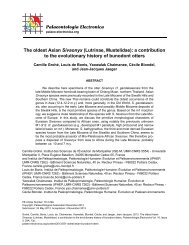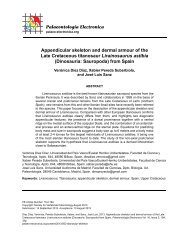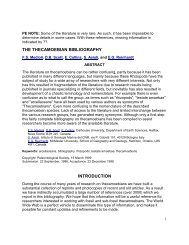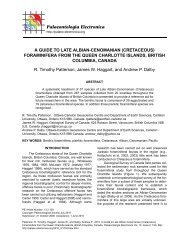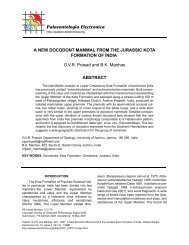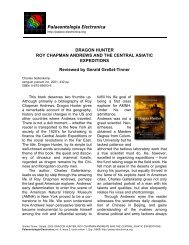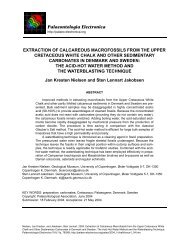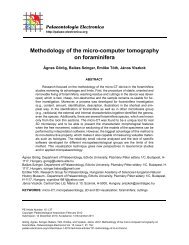Illustration of Modern Benthic Foraminifera from Bermuda and ...
Illustration of Modern Benthic Foraminifera from Bermuda and ...
Illustration of Modern Benthic Foraminifera from Bermuda and ...
You also want an ePaper? Increase the reach of your titles
YUMPU automatically turns print PDFs into web optimized ePapers that Google loves.
JAVAUX AND SCOTT: BENTHIC FORAMINIFERA FROM BERMUDA<br />
Florida-Bahamas; <strong>and</strong> in backreefs <strong>and</strong> reefs <strong>of</strong><br />
the Belize Shelf.<br />
Genus DISCORINOPSIS Cole 1941<br />
Discorinopsis aguayoi (Bermudez) 1935<br />
Figure 6.1 <strong>and</strong> 6.2<br />
v. 1935 Discorbis aguayoi Bermudez, 1935, p. 204,<br />
pl. 15, figs. 10-14.<br />
v. 1953 Discorinopsis aguayoi (Bermudez).<br />
Phleger, Parker <strong>and</strong> Peirson, 1953, p. 7, pl. 4, figs.<br />
23, 24. Scott et al. 1990, p. 730, pl. 1, figs. 6a,b.<br />
v. 1963 Trichohyalus aguayoi (Bermudez). Bermudez<br />
<strong>and</strong> Seiglie, 1963, p. 176, pl. 26, fig. 4<br />
v. 1954 Discorinopsis aguayoi (Bermudez). Arnold,<br />
1954, p. 6-12, pl.1, figs. 1-10. Bock, 1971, p. 50, pl.<br />
18, fig. 42. Steinker, 1980, p. 135, pl. 2, fig. 6.<br />
This species is highly variable in test perforation,<br />
test shape, <strong>and</strong> amount <strong>of</strong> spongy material on the<br />
ventral side (Javaux 1999). This variability has<br />
been shown before only in cultured specimens<br />
(Arnold 1954).<br />
This species is one <strong>of</strong> the characteristic species <strong>of</strong><br />
mangrove assemblage in <strong>Bermuda</strong>, <strong>and</strong> also lives<br />
in <strong>Bermuda</strong> l<strong>and</strong>locked marine ponds fringed by<br />
mangroves. It occurs in mangroves <strong>of</strong> Florida-<br />
Bahamas <strong>and</strong> Columbia, <strong>and</strong> in Equator <strong>and</strong> Brazil<br />
(where it is called D. vadescens). It is reported in<br />
nearshore <strong>and</strong> lagoons <strong>of</strong> Florida-Bahamas <strong>and</strong> in<br />
brackish-water <strong>of</strong> Belize Shelf, probably coming<br />
<strong>from</strong> nearby mangrove areas.<br />
Genus ELPHIDIUM de Montfort, 1808<br />
Elphidium advenum (Cushman) 1922<br />
Figure 2.18 <strong>and</strong> 2.19<br />
v. 1884 Polystomella subnodosa Brady, (not von<br />
Munster), 1884, p. 743, pl. 110, , fig. 1.<br />
v. 1922 Polystomella advena Cushman, 1922, p.<br />
56, pl. 9, figs. 11, 12.<br />
v. 1930 Elphidium advenum Cushman. Cushman,<br />
1930, p. 25, pl. 10, figs. 1, 2. Bock, 1971, p. 56, pl.<br />
20. Elphidium sagrum (d'Orbigny), 1839aThis species<br />
occurs in <strong>Bermuda</strong> lagoons. It is also reported<br />
in nearshore-lagoons <strong>of</strong> Florida-Bahamas, Belize<br />
Shelf, <strong>and</strong> probably in other areas under Elphidium<br />
spp.<br />
Elphidium sagrum (d’Orbigny), 1839a<br />
Figure 2.20 <strong>and</strong> 2.21<br />
v. 1839 Polystomella sagra d'Orbigny, 1839a, p.<br />
55, pl. 6, figs. 19, 20.<br />
v. 1920 Polystomella lanieri Cushman, 1920a, p.<br />
72, pl. 11, fig. 22.<br />
v. 1930 Elphidium sagrum (d'Orbigny). Cushman,<br />
1930, p. 24, pl. 9, figs. 5, 6. Bock, 1971, p. 56-57,<br />
pl. 20, figs 11, 12. Steinker, 1980, p. 136, pl. 3, fig.<br />
2.<br />
This species occurs in <strong>Bermuda</strong> lagoons, <strong>and</strong> in<br />
nearshore-lagoons <strong>and</strong> backreefs-reefs <strong>of</strong> Florida-<br />
Bahamas. It might also occur in other areas under<br />
Elphidium spp.<br />
Genus EPONIDES de Montfort, 1808<br />
Eponides rep<strong>and</strong>us (Fichtel <strong>and</strong> Moll), 1798<br />
Figure 3.1 <strong>and</strong> 3.2<br />
v. 1798 Nautilus rep<strong>and</strong>us Fichtel <strong>and</strong> Moll, 1798,<br />
p. 35, pl. 3, figs. a-d.<br />
v. 1960 Eponides rep<strong>and</strong>us (Fichtel <strong>and</strong> Moll).<br />
Barker, 1960, p. 214, pl. 104, fig. 18. Bock, 1971,<br />
p. 58, pl. 21, figs. 6, 7.<br />
This species occurs in <strong>Bermuda</strong> semi-protected<br />
<strong>and</strong> <strong>of</strong>fshore lagoons. It is also reported in forereefinner<br />
<strong>and</strong> outer shelf (5 to 60 metrs depth) <strong>of</strong> Florida-Bahamas,<br />
Venezuela, <strong>and</strong> Barbuda, <strong>and</strong> in<br />
outer reefs <strong>of</strong> Florida-Bahamas. Species <strong>of</strong> this<br />
genus occur in <strong>Bermuda</strong> lagoons (deeper areas).<br />
It is also reported in lagoons <strong>of</strong> Florida-Bahamas,<br />
Puerto Rico, Belize Shelf, <strong>and</strong> Panama.<br />
Genus GYPSINA Carter, 1877<br />
Gypsina vesicularis (Parker <strong>and</strong> Jones), 1860<br />
Figure 3.3<br />
v. 1860 Orbitolina vesicularis Parker <strong>and</strong> Jones,<br />
1860, p. 31.<br />
v. 1975 Gypsina vesicularis (Parker <strong>and</strong> Jones).<br />
Wantl<strong>and</strong>, 1975, p. 397, pl. 12, c.<br />
This species occurs in low abundance in <strong>Bermuda</strong><br />
reefs. It is also reported in forereef <strong>of</strong> the Belize<br />
Shelf <strong>and</strong> could have been overlooked in other<br />
areas due to its unusual morphology.<br />
Genus HAPLOPHRAGMOIDES Cushman, 1910<br />
Haplophragmoides wilberti Andersen, 1953<br />
Figure 6.5 <strong>and</strong> 6.6<br />
v. 1953 Haplophragmoides wilberti Andersen,<br />
1953, p. 21, pl. 4, fig.7. Zaninetti et al., 1977, pl. 1,<br />
figs. 12, 13. Boltovskoy, 1984, fig. 7. Scott et al.,<br />
1990, p. 731, pl. 1, figs. 8a, 8b. Scott et al., 1991,<br />
p. 385, pl. 1, figs 20, 21.<br />
14



